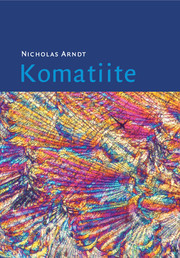Book contents
- Frontmatter
- Contents
- Preface
- Part I Background information – description of the field characteristics, mineralogy and geochemistry of komatiites
- 1 A brief history of komatiite studies and a discussion of komatiite nomenclature
- 2 Brief descriptions of six classic komatiite occurrences
- 3 Field characteristics, textures and structures
- 4 Mineralogy
- 5 Geochemistry
- 6 Isotopic compositions of komatiites
- 7 Experimental petrology
- Part II Interpretation – the manner of emplacement, the origin and the tectonic setting of komatiites
- References
- General index
- Localities
- Plate section
6 - Isotopic compositions of komatiites
from Part I - Background information – description of the field characteristics, mineralogy and geochemistry of komatiites
Published online by Cambridge University Press: 27 August 2009
- Frontmatter
- Contents
- Preface
- Part I Background information – description of the field characteristics, mineralogy and geochemistry of komatiites
- 1 A brief history of komatiite studies and a discussion of komatiite nomenclature
- 2 Brief descriptions of six classic komatiite occurrences
- 3 Field characteristics, textures and structures
- 4 Mineralogy
- 5 Geochemistry
- 6 Isotopic compositions of komatiites
- 7 Experimental petrology
- Part II Interpretation – the manner of emplacement, the origin and the tectonic setting of komatiites
- References
- General index
- Localities
- Plate section
Summary
Introduction
Komatiites were discovered just before the development of the Sm–Nd system as a geochronological tool and geological tracer, and many of the earliest Sm–Nd isochrons included komatiites. As with the earlier geochemical studies, attention was focussed on these ultramafic volcanic rocks because they were thought to provide reliable information about the composition of the Archean mantle (e.g. Zindler (1982)). The argument was that these magmas represent high-degree melts of the mantle and should therefore mirror the composition of their source. Yet it soon became very clear that this was not true, as was strikingly illustrated by the publication of a series of Sm–Nd isochrons with anomalously old ages that were taken as evidence that these komatiites had assimilated large quantities of material from old continental crust.
In this chapter I first review the progress that has been made in the application of five different radiogenic isotopic systems to the investigation of komatiites (Rb–Sr, Sm–Nd, Lu–Hf, Pb–Pb and Re–Os), and I describe how successful (or unsuccessful) each of these methods has been as a means of dating these rocks and as a source of information about their petrogenesis and the nature and composition of their sources in the Archean mantle. I follow this with a brief description of the analysis of stable isotopes in komatiites. For the earlier work I draw heavily on the review papers by Zindler (1982) and Smith and Ludden (1989).
The Rb–Sr system
The first attempts to date komatiites used the Rb–Sr method.
- Type
- Chapter
- Information
- Komatiite , pp. 167 - 201Publisher: Cambridge University PressPrint publication year: 2008



